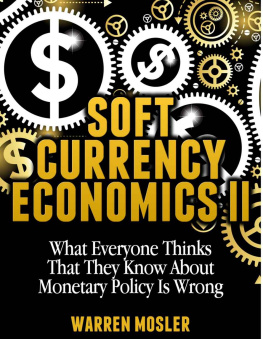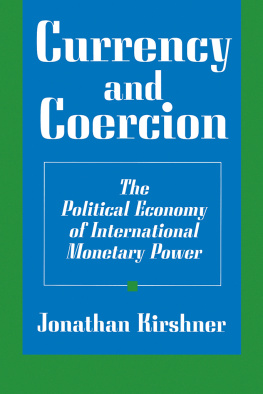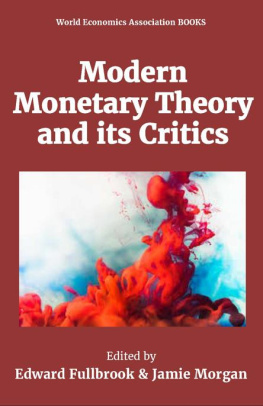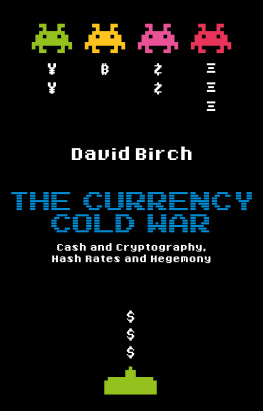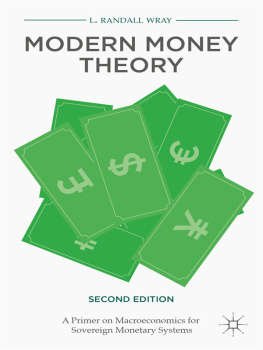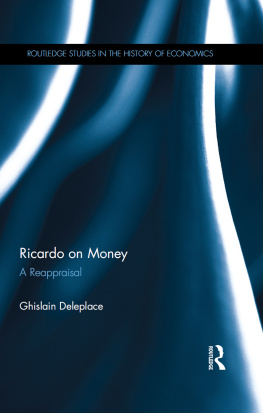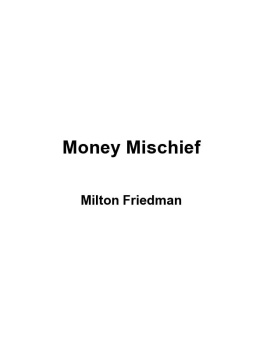Warren Mosler - Soft Currency Economics II (MMT - Modern Monetary Theory Book 1)
Here you can read online Warren Mosler - Soft Currency Economics II (MMT - Modern Monetary Theory Book 1) full text of the book (entire story) in english for free. Download pdf and epub, get meaning, cover and reviews about this ebook. year: 2012, genre: Science. Description of the work, (preface) as well as reviews are available. Best literature library LitArk.com created for fans of good reading and offers a wide selection of genres:
Romance novel
Science fiction
Adventure
Detective
Science
History
Home and family
Prose
Art
Politics
Computer
Non-fiction
Religion
Business
Children
Humor
Choose a favorite category and find really read worthwhile books. Enjoy immersion in the world of imagination, feel the emotions of the characters or learn something new for yourself, make an fascinating discovery.
- Book:Soft Currency Economics II (MMT - Modern Monetary Theory Book 1)
- Author:
- Genre:
- Year:2012
- Rating:4 / 5
- Favourites:Add to favourites
- Your mark:
- 80
- 1
- 2
- 3
- 4
- 5
Soft Currency Economics II (MMT - Modern Monetary Theory Book 1): summary, description and annotation
We offer to read an annotation, description, summary or preface (depends on what the author of the book "Soft Currency Economics II (MMT - Modern Monetary Theory Book 1)" wrote himself). If you haven't found the necessary information about the book — write in the comments, we will try to find it.
Soft Currency Economics II (MMT - Modern Monetary Theory Book 1) — read online for free the complete book (whole text) full work
Below is the text of the book, divided by pages. System saving the place of the last page read, allows you to conveniently read the book "Soft Currency Economics II (MMT - Modern Monetary Theory Book 1)" online for free, without having to search again every time where you left off. Put a bookmark, and you can go to the page where you finished reading at any time.
Font size:
Interval:
Bookmark:
Soft Currency Economics II
WHAT EVERYONE THINKS THEY KNOW ABOUT MONETARY POLICY IS WRONG
By WarrenMosler
All Rights Reserved.No part of this publication may be reproduced in any form or by any means,including scanning, photocopying, or otherwise without prior written permissionof the copyright holder.
Copyright 1996 & 2012 Valance Company, Inc.
Valance Company, Inc.
5013 ChandlersWharf, Suite 2
Christiansted, USVI 00820
Office phone: ( 340)692-7710 (fax 7715)
Next Book in the Series
WarrenMosler; 7Deadly Innocent Frauds of Economic Policy
TABLE OF CONTENTS
Soft Currency Economics was first published after the author,Warren Mosler, founder of Illinois Income Investors (which later became the topranking III investment companies), triggered an Italian Epiphany in Rome in1992. He met with the Professor Luigi Spaventa, a senior official of theItalian Governments Treasury Department, to discuss why Italian governmentbonds were trading at a steep discount to Italian corporate bonds. At the time,the discount existed because the perception was that Italy, not the largeItalian corporations, was more likely to default on its debt. This was contraryto Moslers understanding of fiat currencies. He was convinced that a sovereignwith its own free trading currency could never default unless it was thegovernment's decision to default.
Mosler had Spaventa validate and confirm his thinking that themarket had the pricing all wrong. This lead to very successful trades forMosler, what he referred to a free 2% return, and at the same time educatedSpaventa that Italy (this was prior to the Euro) could not go bankrupt unlessit wanted to, and thus Italy did not have to succumb to the pressure from theIMF to implement austerity programs.
The Italian Epiphany subsequently led to the publication ofSoft Currency Economics in 1996. The book became the cornerstone for aheterodox economic theory that is today known as Modern Monetary Theory or MMT.The book explains how the monetary system and banks really operate in contrastto what is taught in most of todays textbooks.
It is often said that history repeats itself. Twenty years afterthe Italian Epiphany, Italy is once again experiencing financialdifficulties and there is once again a discussion of the potential for default.One major difference exists today compared to the early 1990s and that is themonetary system that existed in the 1990s no longer applies. Today, Italy nolonger has its own free trading fiat currency that it can issue to paygovernment expenditures. Instead, Italy now has to borrow Euros to fundexpenditures and it is the European Central Bank (ECB), not the Italian CentralBank, which can provide the economic remedy.
At the Debt Public Management conference in Rome on October 26,2012 which included Mario Draghi (head of the ECB), Mosler proposed thefollowing three strategies to address the problems in many the Europeaneconomies:
A tax credit bond, which is a bond that in the case of nonpaymentcan be used directly for the payment of taxes;
An ECB guarantee of national government debt and an expansion ofMaastricht limits to perhaps 7% of GDP to trigger an immediate surge of sales; and/or
For the ECB to make cash distributions to the member nations ona per capita basis of perhaps 10% of euro zone GDP annually.
This re-publication of Soft Currency Economics has two newadditions. It includes Moslers personal recollection of his Italian Epiphanyas well as the speech he presented at the Debt Public Management conference.
Russell Huntley, Editor
Circumstances in the early 1990s led me to an understanding ofthe actual functioning of a currency. Back then, it was the government ofItaly, rather than the United States, which was in crisis. Professor RudiDornbusch, an influential academic economist at MIT, insisted that Italy was onthe verge of default because their debt-to-GDP ratio exceeded 110% and the lirainterest rate was higher than the Italian growth rate.
Things were so bad that Italian Government Securities denominatedin lira yielded about 2% more than the cost of borrowing the lira from thebanks. The perceived risk of owning Italian government bonds was so high thatyou could buy Italian government securities at about 14%, and borrow the lirato pay for them from the banks at only about 12% for the full term of thesecurities. This was a free lunch of 2%, raw meat for any bond desk like mine,apart from just one thing; the perceived risk of default by the Italiangovernment. There was easy money to be made, but only if you knew for sure thatthe Italian government wouldnt default.
The Free Lunch possibility totally preoccupied me. The rewardfor turning this into a risk free spread was immense. So I startedbrainstorming the issue with my partners. We knew no nation had ever defaultedon its own currency when it was not legally convertible into gold or anythingelse. There was a time when nations issued securities that were convertibleinto gold. That era, however, ended for good in 1971 when President Nixon tookus off the gold standard internationally (the same year I got my BA fromU-Conn) and we entered the era of floating exchange rates and non-convertiblecurrencies.
While some people still think that the America dollar is backed bythe gold in Fort Knox, which is not the case. If you take a $10 bill to theTreasury Department and demand gold for it, they wont give it to you becausethey simply are not legally allowed to do so, even if they wanted to. They willgive you two $5 bills or ten $1 bills, but forget about getting any gold.
Historically, government defaults came only with the likes of goldstandards, fixed exchange rates, external currency debt, and indexed domesticdebt. But why was that? The answer generally given was because they can alwaysprint the money. Fair enough, but there were no defaults (lots of inflationbut no defaults) and no one ever did print the money, so I needed a betterreason before committing millions of our investors funds.
A few days later when talking to our research analyst, Tom Shulke,it came to me. I said, Tom, if we buy securities from the Fed or Treasury,functionally there is no difference. We send the funds to the same place (theFederal Reserve) and we own the same thing, a Treasury security, which isnothing more than account at the Fed that pays interest.
So functionally it has to all be the same. Yet presumably theTreasury sells securities to fund expenditures, while when the Fed sells securities,its a reserve drain to offset operating factors and manage the fed fundsrate. Yet they have to be functionally the same - its all just a glorifiedreserve drain! Many of my colleagues in the world of hedge fund management wereintrigued by the profit potential that might exist in the 2% free lunch thatthe Government of Italy was offering us. Maurice Samuels, then a portfoliomanager at Harvard Management, immediately got on board, and set up meetingsfor us in Rome with officials of the Italian government to discuss theseissues.
Maurice and I were soon on a plane to Rome. Shortly after landing,we were meeting with Professor Luigi Spaventa, a senior official of the ItalianGovernments Treasury Department. (I recall telling Maurice to duck as weentered the room. He looked up and started to laugh. The opening was maybetwenty feet high. Thats so you could enter this room in Roman times carryinga spear, he replied.) Professor Spaventa was sitting behind an elegant desk.He was wearing a three-piece suit, and smoking one of those curled pipes. Theimage of the great English economist John Maynard Keynes, whose work was at thecenter of much economic policy discussion for so many years, came to mind.Professor Spaventa was Italian, but he spoke English with a British accent,furthering the Keynesian imagery.
Font size:
Interval:
Bookmark:
Similar books «Soft Currency Economics II (MMT - Modern Monetary Theory Book 1)»
Look at similar books to Soft Currency Economics II (MMT - Modern Monetary Theory Book 1). We have selected literature similar in name and meaning in the hope of providing readers with more options to find new, interesting, not yet read works.
Discussion, reviews of the book Soft Currency Economics II (MMT - Modern Monetary Theory Book 1) and just readers' own opinions. Leave your comments, write what you think about the work, its meaning or the main characters. Specify what exactly you liked and what you didn't like, and why you think so.

